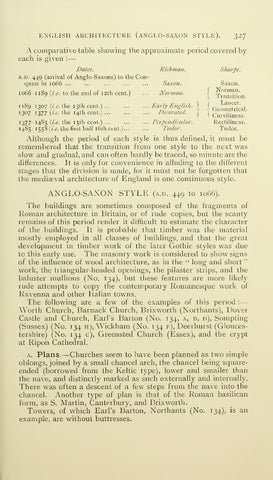—
—
ENGLISH ARCHITECTURE (ANGLO-SAXON STYLE).
A comparative table each
is
given
showing the approximate period covered by
:
Ricknian.
Dates. A.D. 449 (arrival of Anglo-Saxons) to the Con... ... ... ... quest in 1066 ...
1066-1189 ^
(/.f.
1189-1307
(/.^.
to the
end of I2th
^
cent.)
Sharpe.
Saxon.
Saxon.
...
Norman.
^°''"^^"Iransition.
...
Early English.
\
'
the 13th cent.) ^3^7 ^377 W-^- the 14th cent.)
...
...
(
Decorated.
(i.e.
Although the period
...
Cuivilinear. Rectilinear.
Tudor.
Tudor.
...
of each style
Lancet. Geometrical.
Perpendicular.
(
... the 15th cent.) ... i485-i558(/.£. the first half i6th cent.)...
1377-1485
327
thus defined, it niust be remembered that the transition from one style to the next was slow and gradual, and can often hardly be traced, so minute are the differences. It is only for convenience in alluding to the different stages that the division is made, for it must not be forgotten that the mediaeval architecture of England is one continuous style.
ANGLO-SAXON STYLE
is
(a.d.
449 to 1066).
The
buildings are sometimes composed of the fragments of Roman architecture in Britain, or of rude copies, but the scanty remains of this period render it difficult to estimate the character of the buildings. It is probable that timber was the material mostly employed in all classes of buildings, and that the great development in timber work of the later Gothic styles was due The masonry work is considered to show signs to this early use. " of the influence of wood architecture, as in the " long and short work, the triangular-headed openings, the pilaster strips, and the baluster muUions (No. 134), but these features are more likely rude attempts to copy the conteniporary Romanesque work of Ravenna and other Italian towns. The following are a few of the examples of this period Worth Church, Barnack Church, Brixworth (Northants), Dover Castle and Church, Earl's Barton (No. 134, a, b, d), Sompting (Sussex) (No. 134 H), Wickham (No. 134 f), Deerhurst (Gloucestershire) (No. 134 c), Greensted Church (Essex), and the crypt at Ripon Cathedral. :
—
A. Plans. Churches seem to have been planned as two simple oblongs, joined by a small chancel arch, the chancel being squareended (borrowed from the Keltic type), lower and smaller than the nave, and distinctly marked as such externally and internally. There was often a descent of a few steps from the nave into the chancel. Another type of plan is that of the Roman basilican form, as S. Martin, Canterbury, and Brixworth. Towers, of which Earl's Barton, Northants (No. 134), is an example, are without buttresses.
